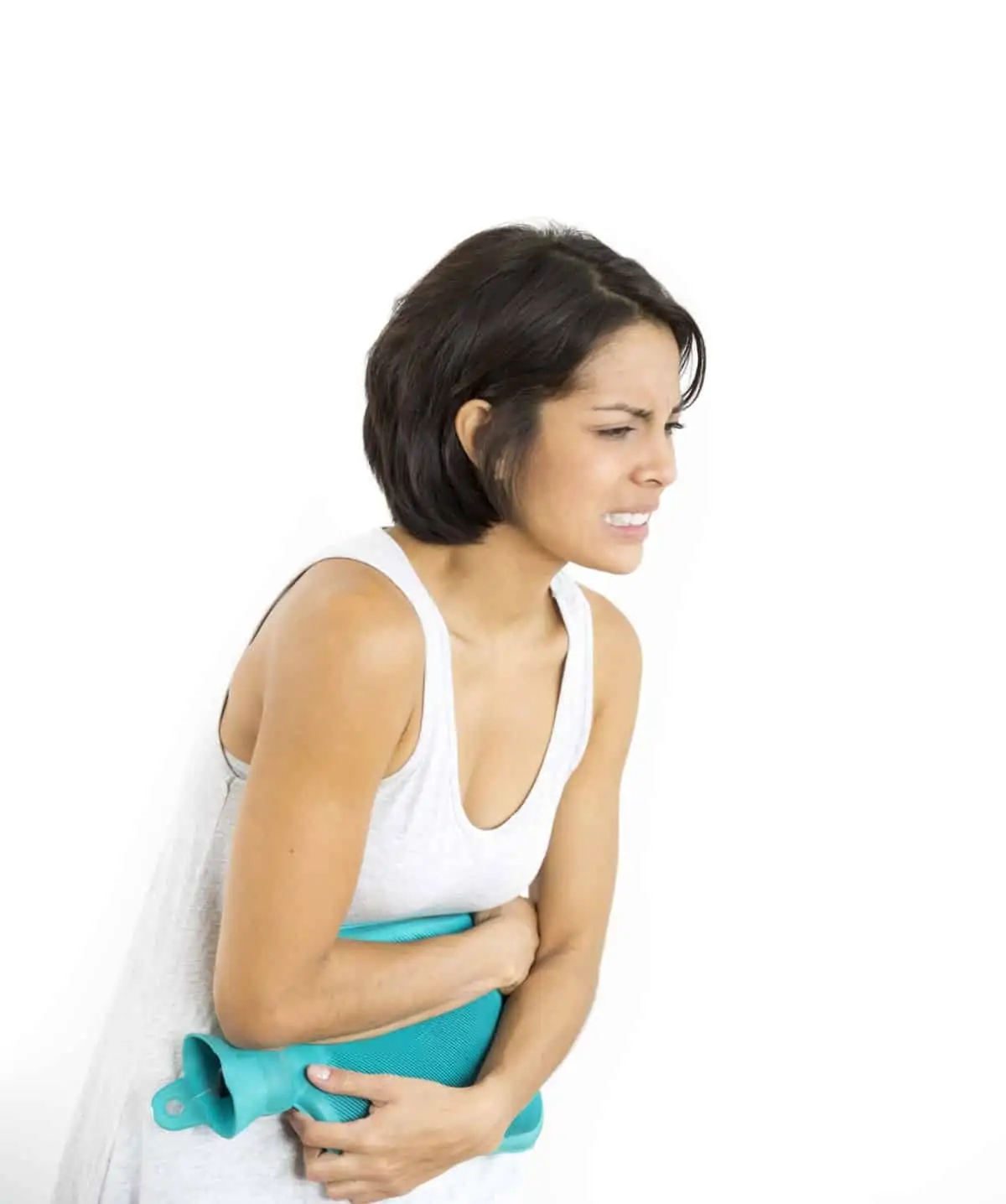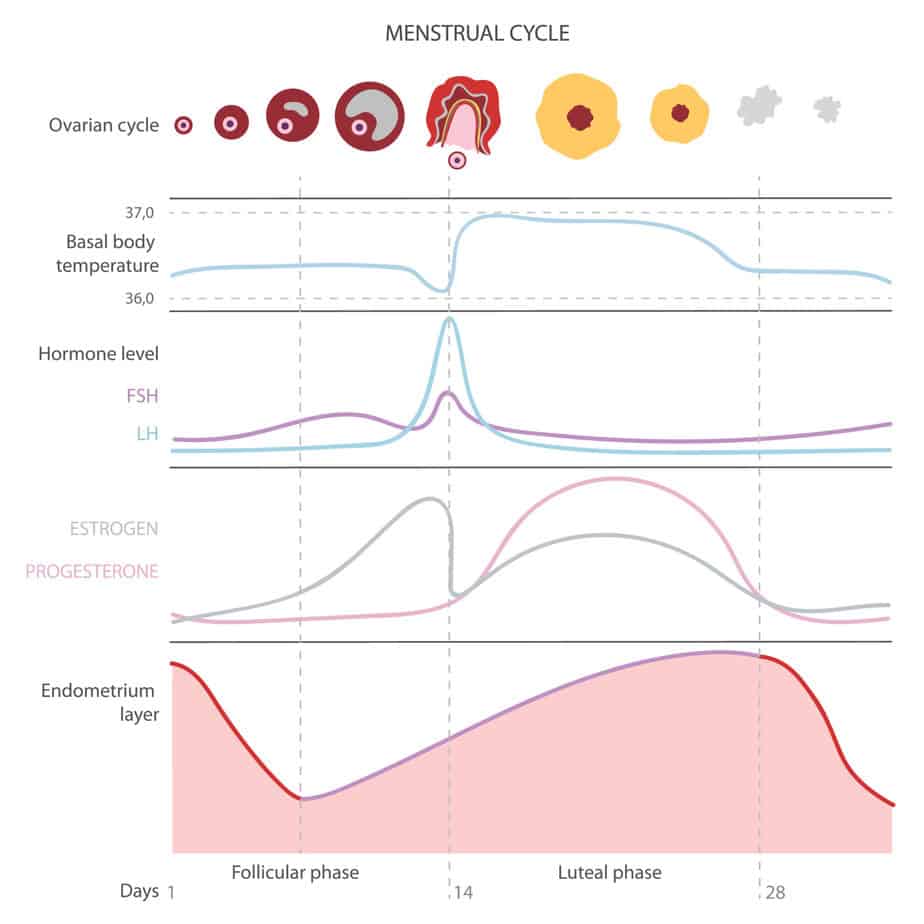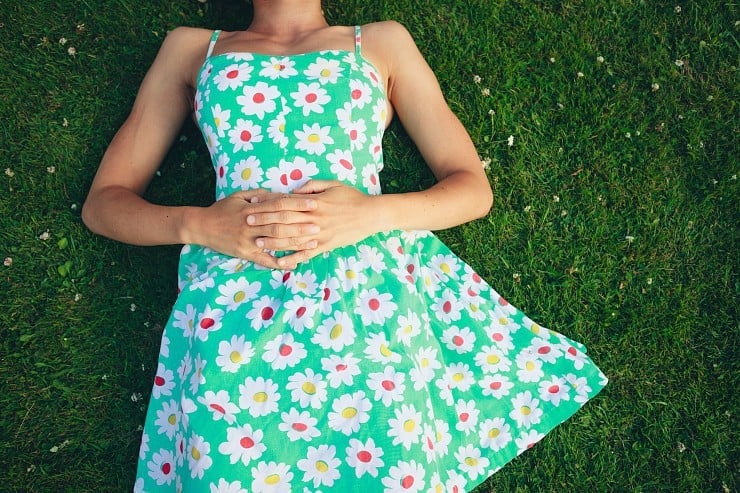Irregular menstrual cycles, PMS, heavy bleeding, migraines, and more – we cover it all in this guide to healthy, normal periods. Plus, 7 signs your period is normal and 12 signs it isn’t!

Note from Dena: This post was co-written with Abbie Womack, Dietetic Intern, as part of a research partnership between Back To The Book Nutrition and post-graduate nutrition students from the University of Houston.
We’ve all been chatting with girlfriends when someone brings up the topic of periods. One woman groans and says her cramps are awful. Another confesses she’s moody, short tempered, and miserable to be around. Others nod in agreement and share their own woes of headaches, tender breasts, and never knowing when the bleeding will hit.
This conversation is not uncommon, but did you know that none of these symptoms are present in a healthy menstrual cycle?
Let’s take a look at what a normal cycle looks like, then we’ll cover 7 signs of a healthy, normal period and 12 signs of an irregular menstrual cycle.
What Happens During a Normal Menstrual Cycle?
A normal monthly menstrual cycle, which begins on the first day of bleeding and lasts until the day your next period begins, looks like this:
The first half of your cycle is called the Follicular Phase. The main female sex hormones, estrogen and progesterone, begin at low levels. This signals the release of a hormone called follicle-stimulating hormone (FSH), which causes the maturation of follicles in the ovaries.
Midway through the cycle, high levels of estrogen cause ovulation to happen, where a mature follicle releases an egg. If you’re tracking your Basal Body Temperature each morning, this is when you should see a spike, followed by higher temperature readings for the rest of your cycle.
The second half of your cycle is called the Luteal Phase. The ruptured follicle causes a surge in progesterone and, to a lesser degree, estrogen, which prepare the uterus for pregnancy by thickening the lining. If the egg is fertilized, it implants in the uterus (pregnancy), and levels of estrogen and progesterone stay high.
If the egg is not fertilized, levels of sex hormones drop, triggering a shedding of the lining of the uterus along with the unfertilized egg. This menstruation kicks off the start of another cycle.
Wondering how this translates to your monthly period experience? Let’s take a closer look at what a healthy, normal period should look like in everyday life.
7 Signs of a Healthy, Normal Period
There is some variation between women but, for the most part, these are the signs of a normal menstrual cycle.
1. PMS is minimal
Some argue that PMS should be nonexistent. I don’t really buy that – with all the hormonal shifts going on, it only makes sense that you might experience mild PMS symptoms, such as breast tenderness, cramps, mood changes, etc. However, you should not feel like an entirely different person, and your friends and family shouldn’t need to walk on eggshells around you the week before your period starts.
2. Your cycle lasts 25-35 days
Count from the start of bleeding one month to the start of bleeding the following month. The exact number of days will vary from woman to woman, but most experts agree this is an acceptable range.
3. Your cycle length is consistent month to month, with a 1-3 day variation
For example, your monthly cycle may range from 28-31 days, but it shouldn’t jump from 28 days to 35, then to 25, then back to 28 again.
4. Your period starts with a bang
Bleeding should be nice and strong on day 1 of your cycle, with bright red blood flow.
5. Bleeding lasts for 4-7 days and is strong, but manageable
You shouldn’t need to stay home or be running to change your tampon every hour to keep up with the flow. When it’s over, it should be over – no trickling off for days on end or stopping, then spotting for a few days.
6. Cervical fluid increases mid-cycle
Seeing clear discharge (similar to raw egg white) for 1-3 days in the middle of your cycle is a sign of ovulation, which is arguably the single most important marker of period health.
7. Basal Body Temperatures dip slightly, then rise sharply mid-cycle
This is another sign of ovulation and one of the main reasons I have most of my female clients track their basal body temperatures each day.
Note: This post contains affiliate links. By making purchases through these links, you pay the same amount for products, but a small portion of the sale will be sent my way to help support the mission of Back To The Book Nutrition. Thank you!
12 Signs that Your Period Isn’t Normal
Here are some markers of am irregular menstrual cycle, and possible contributing factors for each. In my holistic nutrition coaching practice, I meet with women all the time who experience at least some of these. So they are very common – but, make no mistake, they are not normal.
1. You have miserable PMS
Severe breast tenderness, horrible cramps, legendary mood swings, heightened anxiety, and popping Motrin like candy are not normal.
Possible causes: Estrogen excess (more likely if endometriosis, uterine fibroids, or uterine polyps are present), low progesterone, low magnesium, inflammation
2. You suffer from migraines
Most often, these will occur during the week before a woman’s cycle, but they can happen at other times of the month too.
Possible causes: Estrogen excess (more likely if endometriosis, uterine fibroids, or uterine polyps are present), low progesterone, low magnesium, inflammation
3. Irregular Periods
As we already discussed, consistency is key when it comes to your monthly period – having no idea when your period will start or how long it will last isn’t normal.
Possible causes: Thyroid imbalance, stress, polycystic ovarian syndrome (PCOS), inadequate food intake, perimenopause
4. Your monthly cycle is too long or too short
Cycles consistently lasting less than 25 days (some would say less than 21 days) or more than 35 days would fit this description.
Possible causes: Anovulatory cycles (bleeding without ovulating – yes, it can happen), perimenopause, too little or too much estrogen, luteal phase defect
5. You skip periods
Most doctors wait until a woman goes 6 months without a period to officially diagnose “amenorrhea” (lack of periods), but I’d recommend taking action after two months to ensure you don’t get too far behind on correcting the underlying cause.
Possible causes: Inadequate food intake, rapid weight loss, stress, perimenopause, post birth control syndrome (you recently stopped taking hormonal birth control), pregnancy
6. You start with spotting instead of bleeding
This spotting is often brownish rather than red, and may last for one or a few days before true bleeding begins.
Possible causes: Low progesterone, luteal phase defect, having recently started a new hormonal birth control
7. Your bleeding is very light
Usually this includes a lighter color of blood flow (more pinkish than red), a lighter volume (requiring a pantiliner instead of a full pad or tampon), and fewer days of bleeding.
Possible causes: Low estrogen, inadequate nutrient intake
8. Your periods are very heavy
Changing tampons every hour or seeing large, dark blood clots in your menstrual flow isn’t normal.
Possible causes: Estrogen excess (more likely if endometriosis, uterine fibroids, or uterine polyps are present), low progesterone
9. You bleed for longer than a week
Usually this occurs alongside heavier blood flow.
Possible causes: Uterine fibroids, uterine polyps, endometriosis, hypothyroidism, iron deficiency anemia
10. You Don’t Ovulate
Never ovulating, not ovulating consistently each month, or ovulating too early or late in your cycle are all signs that something isn’t right. The best ways to confirm monthly ovulation are with a combination of tracking daily basal body temperatures and cervical mucus,plus taking at-home ovulation tests.
Possible causes: stress, PCOS, luteal phase defect, perimenopause, hormonal birth control, thyroid disease, inadequate nutrient intake, inflammation
11. Mid-cycle Pain
This is significant pain that goes beyond mild discomfort commonly attributed to ovulation related cramps.
Possible causes: Excess testosterone, PCOS, endometriosis, fibroids, inflammation
12. Spotting or bleeding between periods
Possible causes: Endometriosis, uterine fibroids, low progesterone
Other Women’s Health Articles You Might Like:
17 Ways to Balance Hormones Naturally
 10 Steps to Overcome Depression and Anxiety Naturally
10 Steps to Overcome Depression and Anxiety Naturally
 10 Ways to Overcome Acne Naturally
10 Ways to Overcome Acne Naturally
About the Co-Author
Abbie earned her Bachelors and Masters Degrees in Nutritional Sciences from Oklahoma State University, and is currently completing her dietetic internship with the University of Houston before going on to work in the field of eating disorders. Abbie is newly married and enjoys swimming and eating ice cream!
Disclaimer: Information on this site is intended only for informational purposes and is not a substitute for medical advice. Always consult with a trusted healthcare provider before implementing significant dietary change. Read additional disclaimer info here.







Thanks for sharing,
It’s a very informative and interesting article.
I really enjoy your content.
Now I could actually felt what my wife feels everytime she will have this. Thanks for giving us reminder.
Great timing for this post because my cycle started this week. My period is pretty normal and I can’t stand when it starts off when a bang.
Your article reminded me of the pain I suffer in my course
But it’s okay because it doesn’t last long
After reading this I realize that I have NORMAL PERIOD cycle to this I’ve learn something to this post!
I am glad that it was helpful to you!
That is so weird! My wife got her period this morning and it felt not normal! The information you provided actually helped a lot, thank you.
Great topic of specific awareness. It will me more useful of your targeted readers.
You have provided an informative and educative article here, it all depends on body type as well, some people do not even know that they are passing through all these.
Thanks for sharing Emidev, and we are gald that you found the post informational!
ha. . ha.. I am a husband and father. So, my wife and daughters should read this article.
I haven’t had my period yet but I my boobs hurt and I have stomach cramps and white fluid come out. I’m 12 years old in BMS
Hi there,
It sounds like you should get an evaluation from your pediatrician. They can tell you whether those are just signs that your body is preparing to start your period, or whether something else is going on.
Thank you very much.i have learnt a lot.
I usually start spotting before bleeding.